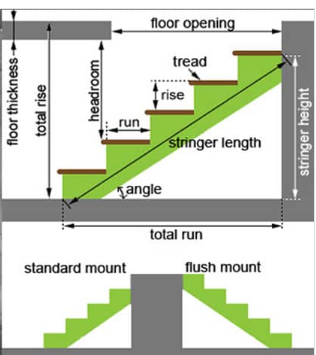

Instantly calculate stair dimensions including total rise, step height, run length, and stringer cut. Ideal for construction pros and DIY stair builders.


Take this 10-question quiz to test your understanding of stair design and construction principles. Each question is based on real-world scenarios and building codes.
| Parameter | Standard Value (U.S. Code) |
|---|---|
| Max Riser Height | 7.75 inches |
| Min Tread Depth | 10 inches |
| Ideal Stair Angle | 30°–37° |
| Headroom Clearance | 6 ft 8 in (min) |
| Fraction | Decimal |
|---|---|
| 1/16 | 0.0625 |
| 1/8 | 0.125 |
| 1/4 | 0.25 |
| 1/2 | 0.5 |
| 3/4 | 0.75 |
Proper stair design is crucial for both safety and comfort. The relationship between rise and run determines the steepness and comfort of a staircase. The ideal stair follows the "rule of thumb" that twice the rise plus the run should equal approximately 25 inches (63.5 cm).
The choice of material affects both the aesthetics and durability of your stairs:
Ensure all risers are the same height and all treads are the same depth. Variations as small as 1/4 inch can cause tripping hazards.
Most building codes require handrails on stairs with more than three risers. The standard height is 34-38 inches from the tread to the top of the rail.
For long stair runs, include landings every 12 feet or when a staircase changes direction. Landings should be at least as wide as the stairs and 36 inches deep.
Remember to include the thickness of finished flooring when calculating your total rise. This affects the final height of each step.
Before cutting materials, create a full-scale template of your stair design on the floor to verify dimensions and comfort.
At Calculator Premium, we offer a wide variety of specialized calculators designed to simplify complex calculations across multiple domains. Our user-friendly tools provide accurate results instantly, saving you time and effort.
From basic arithmetic to advanced calculus, our math calculators handle everything you need.
Professional tools for engineers and students. Calculate structural loads, electrical parameters, and more.
Monitor your health with our medical calculators. Calculate BMI, BMR, calorie needs, and more.
Make informed financial decisions with our money calculators. Plan loans, investments, and more.
Manage your time efficiently with our date and time tools. Calculate durations and plan schedules.
Essential tools for construction professionals. Calculate material quantities, measurements, and costs.
If you find this calculator useful, consider supporting us with a small donation
Buy Me a CoffeeDiscover our full range of calculators and tools for your projects
Visit CalculatorPremium.com